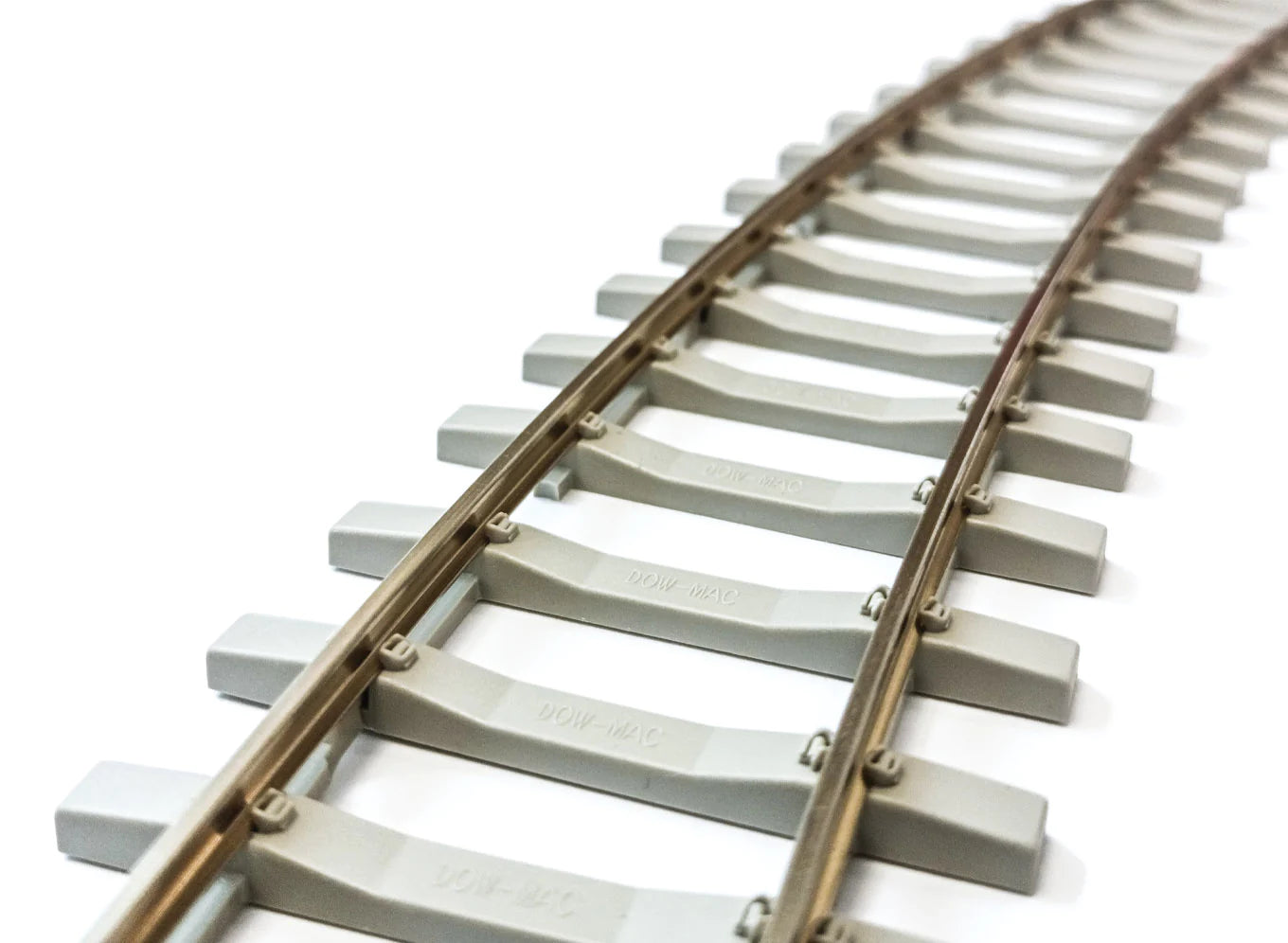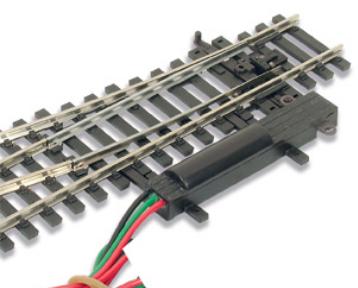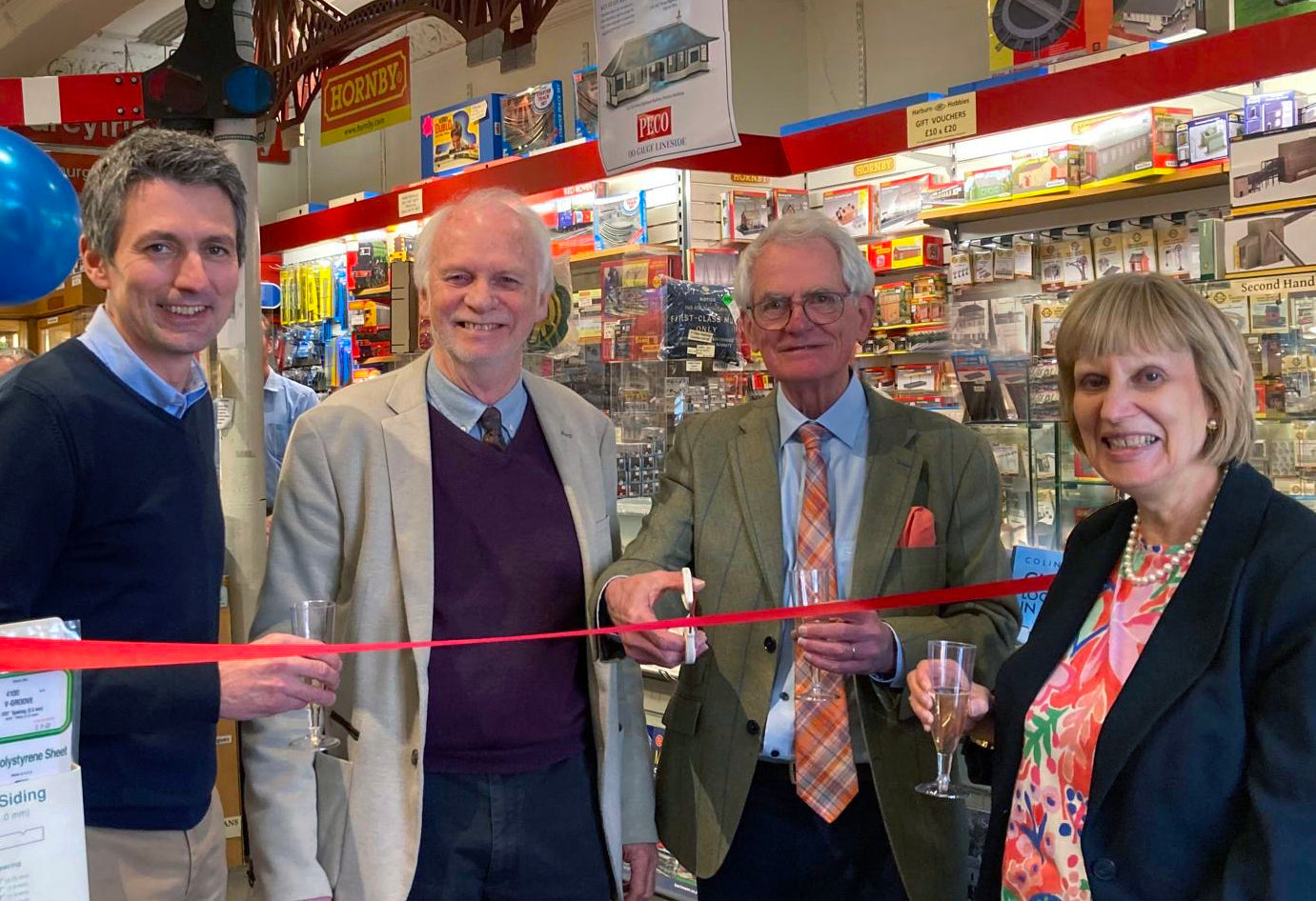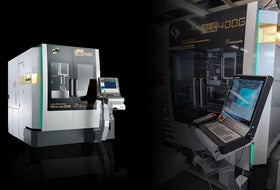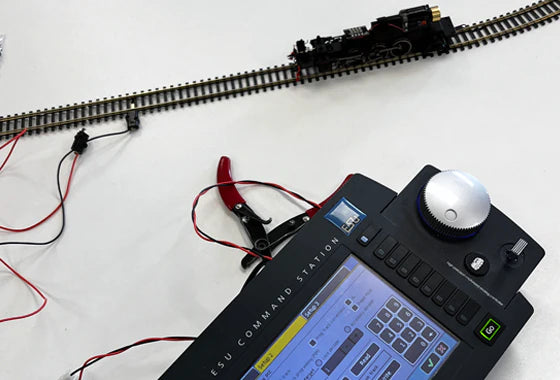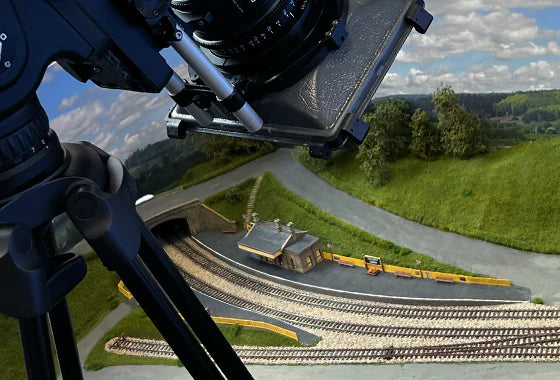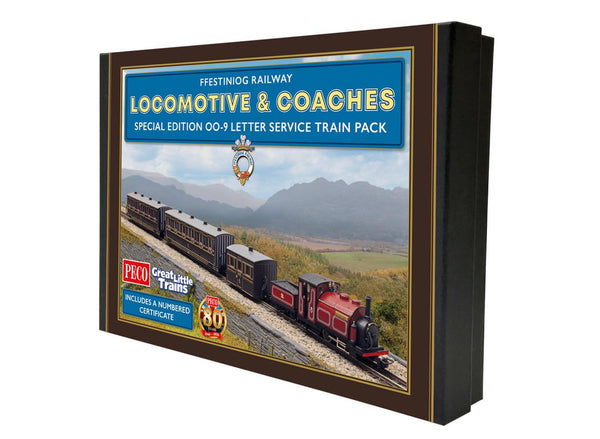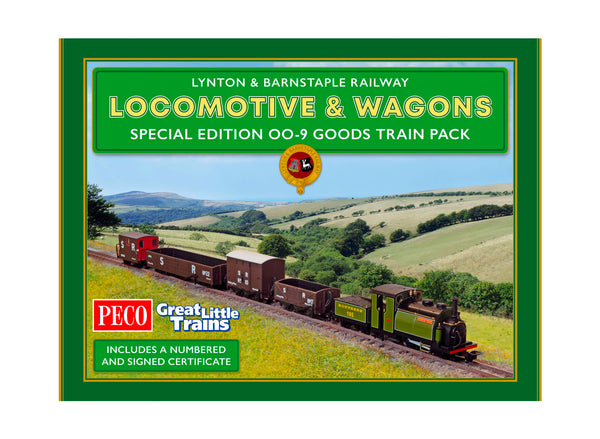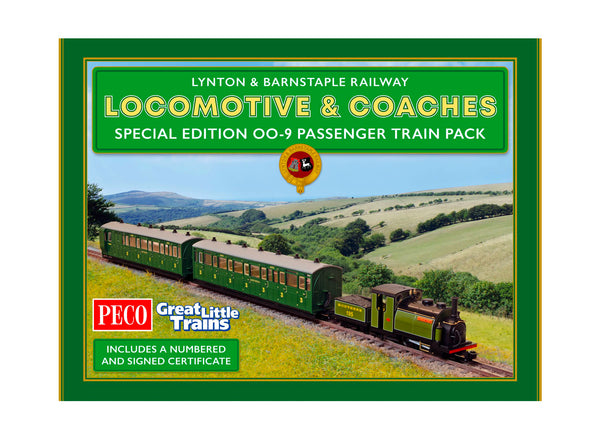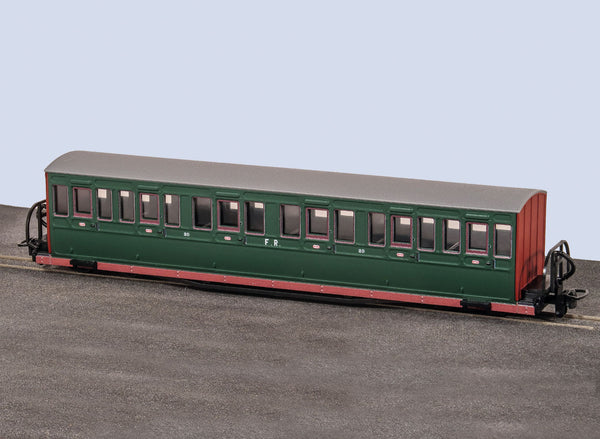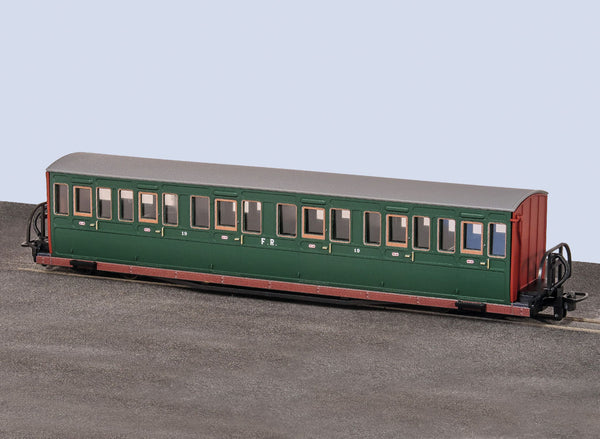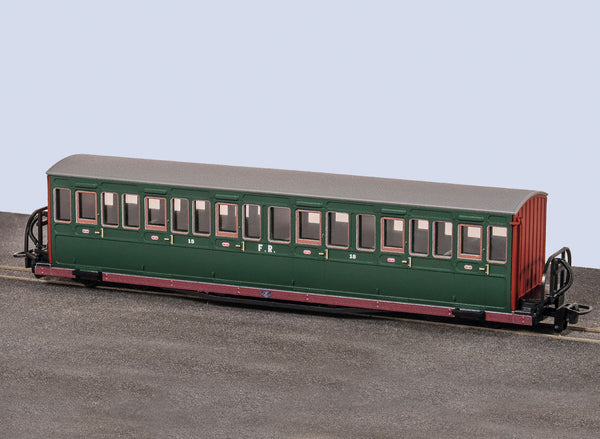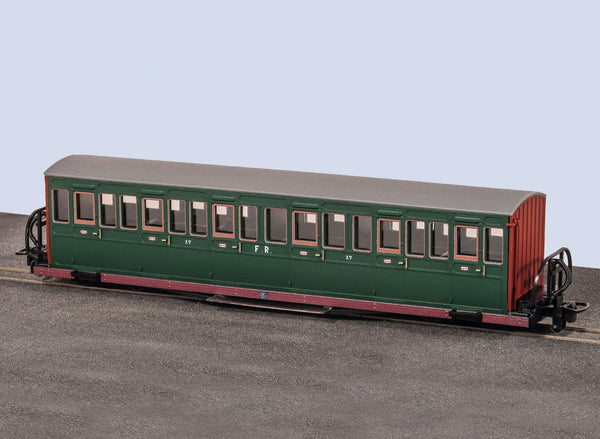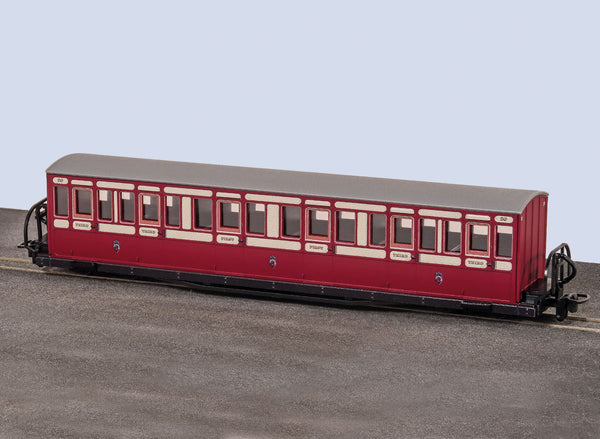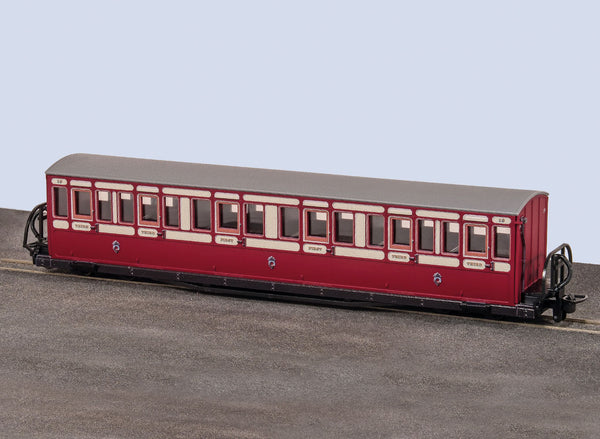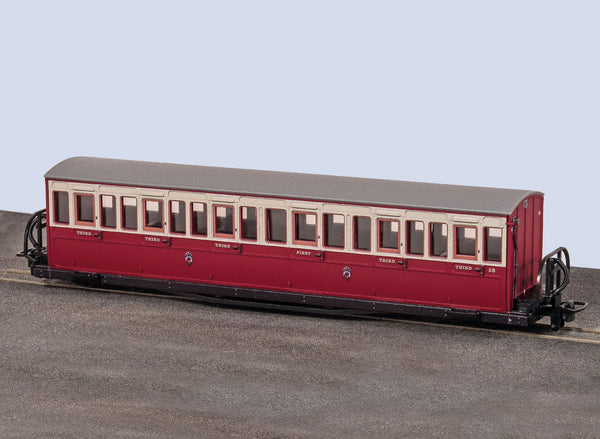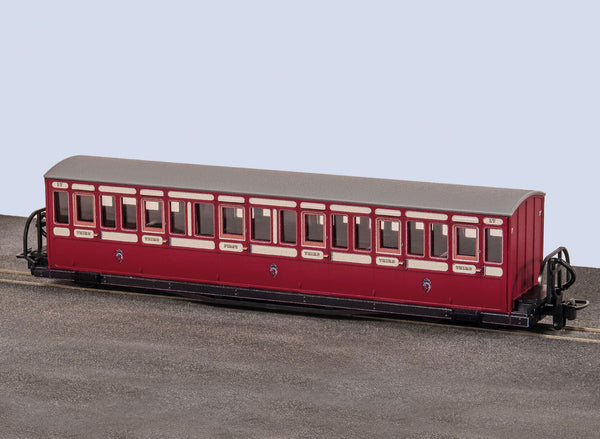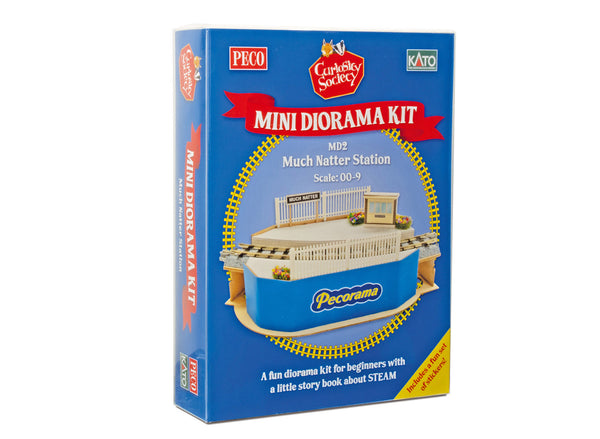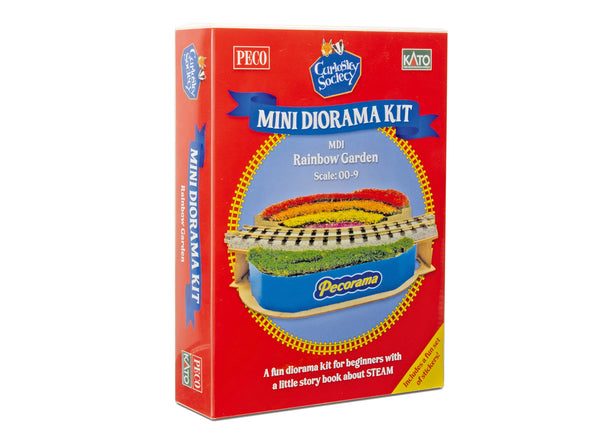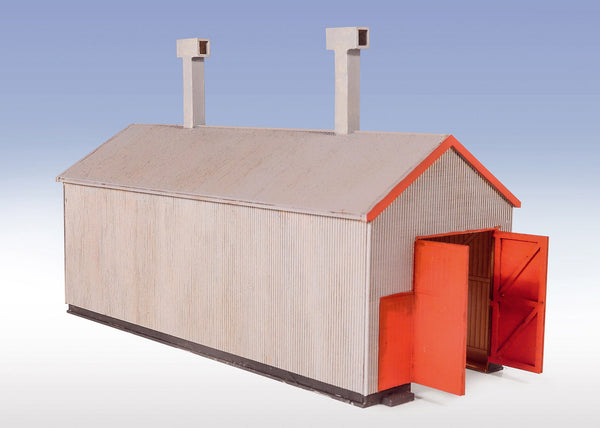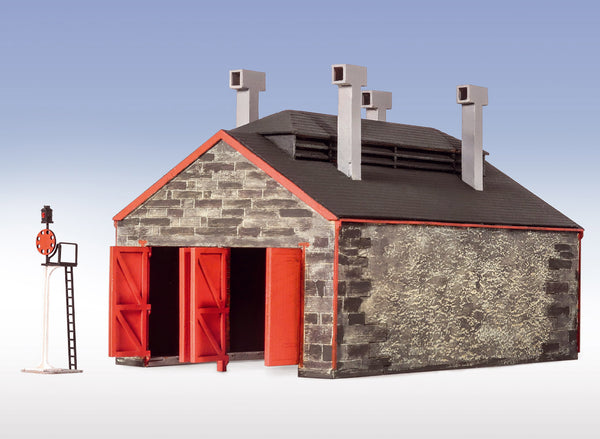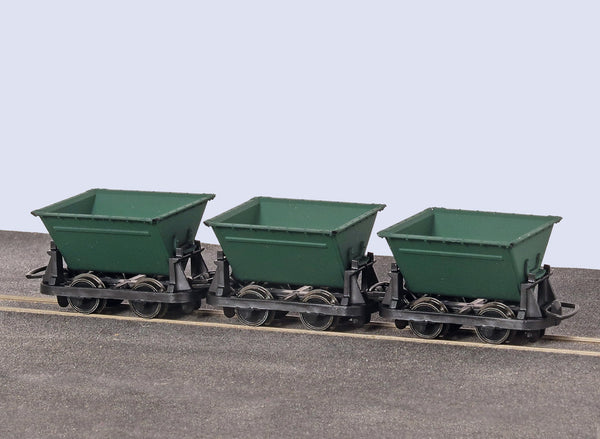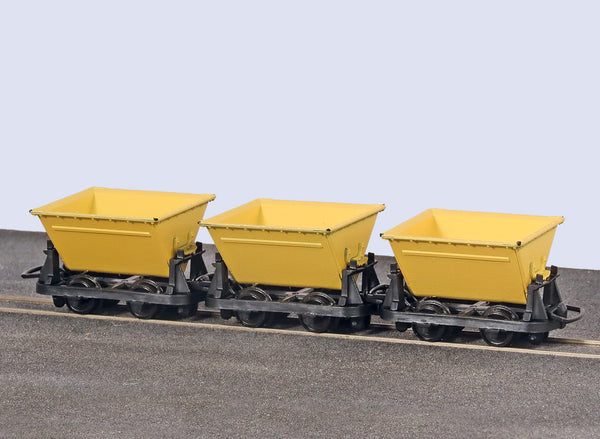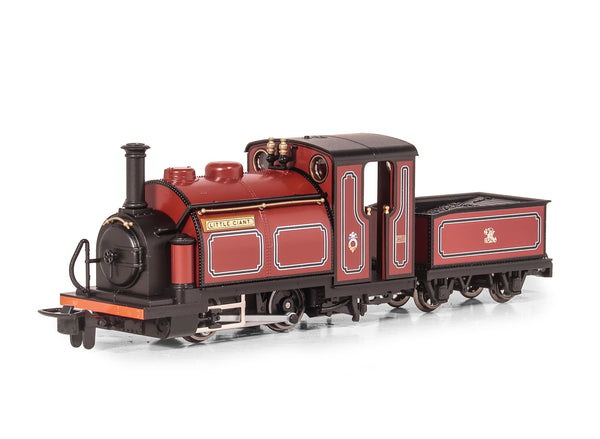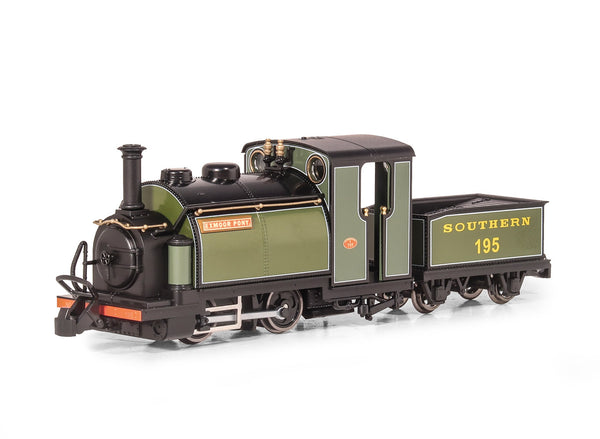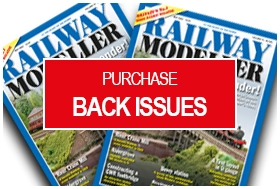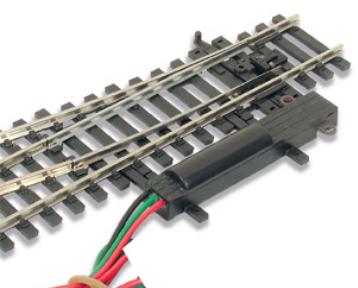BROWSE PECO PRODUCTS
Browse through our complete product portfolio.
32 Products Found
Special Edition OO-9 Letter Service Train Pack (Ffestiniog Railway)
The Ffestiniog Railway, located in North Wales, is the world’s oldest surviving independent railway company, founded in 1832. Originally built to transport slate from the quarries of Blaenau Ffestiniog to the port at Porthmadog, it was engineered with a unique narrow gauge of just 1 ft 11½ in (597 mm), ideal for winding through the rugged Snowdonia landscape. Innovative features included gravity-powered slate trains running downhill and horses hauling the wagons back uphill.
In the 1860s, steam locomotives were introduced, making the Ffestiniog the first narrow-gauge railway in the world to successfully use them. After declining slate demand led to closure in 1946, dedicated volunteers began restoring the line in the 1950s. Today, it runs as a popular heritage railway, linking Porthmadog to Blaenau Ffestiniog once again, and is celebrated for its pioneering engineering, scenic beauty, and remarkable preservation story.
These latest PECO train packs celebrate that legacy with attention to authenticity and a passion for detail.
Special Edition OO-9 Press Train Pack (Welsh Highland Railway)
The Ffestiniog Railway, located in North Wales, is the world’s oldest surviving independent railway company, founded in 1832. Originally built to transport slate from the quarries of Blaenau Ffestiniog to the port at Porthmadog, it was engineered with a unique narrow gauge of just 1 ft 11½ in (597 mm), ideal for winding through the rugged Snowdonia landscape. Innovative features included gravity-powered slate trains running downhill and horses hauling the wagons back uphill.
In the 1860s, steam locomotives were introduced, making the Ffestiniog the first narrow-gauge railway in the world to successfully use them. After declining slate demand led to closure in 1946, dedicated volunteers began restoring the line in the 1950s. Today, it runs as a popular heritage railway, linking Porthmadog to Blaenau Ffestiniog once again, and is celebrated for its pioneering engineering, scenic beauty, and remarkable preservation story.
These latest PECO train packs celebrate that legacy with attention to authenticity and a passion for detail.
Special Edition OO-9 Goods Train Pack
Inspired by one of Britain’s most beloved narrow-gauge railways – the Lynton & Barnstaple, these exclusive new packs feature the beautifully detailed KATO Large England locomotive “Exmoor Pony” paired with unique-liveried rolling stock – only available in these sets and not sold separately.
Each pack comes in a smart, collector-style presentation box, complete with custom packaging and a striking outer sleeve – perfect for displaying or gifting.
Special Edition OO-9 Passenger Train Pack
Inspired by one of Britain’s most beloved narrow-gauge railways – the Lynton & Barnstaple, these exclusive new packs feature the beautifully detailed KATO Large England locomotive “Exmoor Pony” paired with unique-liveried rolling stock – only available in these sets and not sold separately.
Each pack comes in a smart, collector-style presentation box, complete with custom packaging and a striking outer sleeve – perfect for displaying or gifting.
FR Long 'Bowsider' Coach - Colonel Stephens No.20
The Ffestiniog Railway operated two pairs of bogie coaches numbered 17-20 and built by Brown Marshalls & Co and Gloucester Wagon Co. They were known as ‘Bowsiders’ because of the tumblehome shape of their sides. Numbers 17 and 18, built in 1876 are shorter with one 1st class compartment. Numbers 19 and 20, built in 1879 are longer with two 1st class compartments. All four are still in service on the Ffestiniog Railway today.
In the 1920s the elaborate liveries of the Victorian era were replaced with a simple scheme of green with red end panels. It became known as the ‘Colonel Stephens’ livery, after the General Manager of the Ffestiniog Railway from 1925 until his passing in 1931. The colour scheme was used until the end of passenger operations in 1939, sometimes alongside other colours such as yellow, in the mid 1930s.
Green with red ends was applied to carriage No.20 once again from 2005 until 2024, as depicted by GR-623B.
FR Long 'Bowsider' Coach - Colonel Stephens No.19
The Ffestiniog Railway operated two pairs of bogie coaches numbered 17-20 and built by Brown Marshalls & Co and Gloucester Wagon Co. They were known as ‘Bowsiders’ because of the tumblehome shape of their sides. Numbers 17 and 18, built in 1876 are shorter with one 1st class compartment. Numbers 19 and 20, built in 1879 are longer with two 1st class compartments. All four are still in service on the Ffestiniog Railway today.
In the 1920s the elaborate liveries of the Victorian era were replaced with a simple scheme of green with red end panels. It became known as the ‘Colonel Stephens’ livery, after the General Manager of the Ffestiniog Railway from 1925 until his passing in 1931. The colour scheme was used until the end of passenger operations in 1939, sometimes alongside other colours such as yellow, in the mid 1930s.
Green with red ends was applied to carriage No.20 once again from 2005 until 2024, as depicted by GR-623B.
FR Short 'Bowsider' Coach - Colonel Stephens No.18
The Ffestiniog Railway operated two pairs of bogie coaches numbered 17-20 and built by Brown Marshalls & Co and Gloucester Wagon Co. They were known as ‘Bowsiders’ because of the tumblehome shape of their sides. Numbers 17 and 18, built in 1876 are shorter with one 1st class compartment. Numbers 19 and 20, built in 1879 are longer with two 1st class compartments. All four are still in service on the Ffestiniog Railway today.
In the 1920s the elaborate liveries of the Victorian era were replaced with a simple scheme of green with red end panels. It became known as the ‘Colonel Stephens’ livery, after the General Manager of the Ffestiniog Railway from 1925 until his passing in 1931. The colour scheme was used until the end of passenger operations in 1939, sometimes alongside other colours such as yellow, in the mid 1930s.
Green with red ends was applied to carriage No.20 once again from 2005 until 2024, as depicted by GR-623B.
FR Short 'Bowsider' Coach - Colonel Stephens No.17
The Ffestiniog Railway operated two pairs of bogie coaches numbered 17-20 and built by Brown Marshalls & Co and Gloucester Wagon Co. They were known as ‘Bowsiders’ because of the tumblehome shape of their sides. Numbers 17 and 18, built in 1876 are shorter with one 1st class compartment. Numbers 19 and 20, built in 1879 are longer with two 1st class compartments. All four are still in service on the Ffestiniog Railway today.
In the 1920s the elaborate liveries of the Victorian era were replaced with a simple scheme of green with red end panels. It became known as the ‘Colonel Stephens’ livery, after the General Manager of the Ffestiniog Railway from 1925 until his passing in 1931. The colour scheme was used until the end of passenger operations in 1939, sometimes alongside other colours such as yellow, in the mid 1930s.
Green with red ends was applied to carriage No.20 once again from 2005 until 2024, as depicted by GR-623B.
FR Long 'Bowsider' Coach - Red & Cream No.20
The Ffestiniog Railway operated two pairs of bogie coaches numbered 17-20 and built by Brown Marshalls & Co and Gloucester Wagon Co. They were known as ‘Bowsiders’ because of the tumblehome shape of their sides. Numbers 17 and 18, built in 1876 are shorter with one 1st class compartment. Numbers 19 and 20, built in 1879 are longer with two 1st class compartments. All four are still in service on the Ffestiniog Railway today.
The red and cream livery was first applied to a rake of carriages in 1987 for the ‘Mountain Prince’ train service. Carriage 20 was the first Bowsider to appear in the livery.
Carriages 17 and 18 had cream applied to the full upper half of the carriage. 17 had the mouldings reinstated in 1990 as depicted by GR-602A. 18 continued to have cream across the upper half throughout its time in the scheme, as represented by GR-602B. Note the ‘Brown Marshalls & Co. Ltd’ builders plate printed on the ends of the carriage.
All four Bowsiders were repainted into historic liveries in the 2000s, but the red and cream colour scheme is still seen today on the more modern carriages
FR Long 'Bowsider' Coach - Red & Cream No.19
The Ffestiniog Railway operated two pairs of bogie coaches numbered 17-20 and built by Brown Marshalls & Co and Gloucester Wagon Co. They were known as ‘Bowsiders’ because of the tumblehome shape of their sides. Numbers 17 and 18, built in 1876 are shorter with one 1st class compartment. Numbers 19 and 20, built in 1879 are longer with two 1st class compartments. All four are still in service on the Ffestiniog Railway today.
The red and cream livery was first applied to a rake of carriages in 1987 for the ‘Mountain Prince’ train service. Carriage 20 was the first Bowsider to appear in the livery.
Carriages 17 and 18 had cream applied to the full upper half of the carriage. 17 had the mouldings reinstated in 1990 as depicted by GR-602A. 18 continued to have cream across the upper half throughout its time in the scheme, as represented by GR-602B. Note the ‘Brown Marshalls & Co. Ltd’ builders plate printed on the ends of the carriage.
All four Bowsiders were repainted into historic liveries in the 2000s, but the red and cream colour scheme is still seen today on the more modern carriages
FR Short 'Bowsider' Coach - Red & Cream No.18
The Ffestiniog Railway operated two pairs of bogie coaches numbered 17-20 and built by Brown Marshalls & Co and Gloucester Wagon Co. They were known as ‘Bowsiders’ because of the tumblehome shape of their sides. Numbers 17 and 18, built in 1876 are shorter with one 1st class compartment. Numbers 19 and 20, built in 1879 are longer with two 1st class compartments. All four are still in service on the Ffestiniog Railway today.
The red and cream livery was first applied to a rake of carriages in 1987 for the ‘Mountain Prince’ train service. Carriage 20 was the first Bowsider to appear in the livery.
Carriages 17 and 18 had cream applied to the full upper half of the carriage. 17 had the mouldings reinstated in 1990 as depicted by GR-602A. 18 continued to have cream across the upper half throughout its time in the scheme, as represented by GR-602B. Note the ‘Brown Marshalls & Co. Ltd’ builders plate printed on the ends of the carriage.
All four Bowsiders were repainted into historic liveries in the 2000s, but the red and cream colour scheme is still seen today on the more modern carriages
FR Short 'Bowsider' Coach - Red & Cream No.17
The Ffestiniog Railway operated two pairs of bogie coaches numbered 17-20 and built by Brown Marshalls & Co and Gloucester Wagon Co. They were known as ‘Bowsiders’ because of the tumblehome shape of their sides. Numbers 17 and 18, built in 1876 are shorter with one 1st class compartment. Numbers 19 and 20, built in 1879 are longer with two 1st class compartments. All four are still in service on the Ffestiniog Railway today.
The red and cream livery was first applied to a rake of carriages in 1987 for the ‘Mountain Prince’ train service. Carriage 20 was the first Bowsider to appear in the livery.
Carriages 17 and 18 had cream applied to the full upper half of the carriage. 17 had the mouldings reinstated in 1990 as depicted by GR-602A. 18 continued to have cream across the upper half throughout its time in the scheme, as represented by GR-602B. Note the ‘Brown Marshalls & Co. Ltd’ builders plate printed on the ends of the carriage.
All four Bowsiders were repainted into historic liveries in the 2000s, but the red and cream colour scheme is still seen today on the more modern carriages
PECO/KATO Diorama Kit - 'Pecorama Much Natter Station' - 00-9
For newcomers to modelling who are interested in making a diorama but do not know exactly where to start, this is a lovely introductory set to allow you to model something yourself and create your own small-scale model. It contains all the necessary materials for creating the diorama layout, and also an illustrated story book that children can enjoy reading at bedtime.
These little diorama kits also allow more experienced modellers to try building their own unique scene, and can be joined together to make a working and functional group of mini dioramas that can be used to make a working circuit. This can be great for modelling clubs, associations or schools, and can bring modellers together in group projects - to help focus on the dexterous skills and create something all by themselves.
As well as a a beautifully illustrated book, these kits include all the materials and scenery required, as well as a set of FREE stickers!
- Time required to complete: about 2 ~ 3 hours (excluding drying time)
-
Suggested age: 8 yrs+ (Supervision recommended)
PECO/KATO Diorama Kit - 'Pecorama Rainbow Garden' - 00-9
For newcomers to modelling who are interested in making a diorama but do not know exactly where to start, this is a lovely introductory set to allow you to model something yourself and create your own small-scale model. It contains all the necessary materials for creating the diorama layout, and also an illustrated story book that children can enjoy reading at bedtime.
These little diorama kits also allow more experienced modellers to try building their own unique scene, and can be joined together to make a working and functional group of mini dioramas that can be used to make a working circuit. This can be great for modelling clubs, associations or schools, and can bring modellers together in group projects - to help focus on the dexterous skills and create something all by themselves.
As well as a a beautifully illustrated book, these kits include all the materials and scenery required, as well as a set of FREE stickers!
- Time required to complete: about 2 ~ 3 hours (excluding drying time)
-
Suggested age: 8 yrs+ (Supervision recommended)
OO/HO/OO-9 Corrugated Engine Shed Lasercut Kit
Based on the buildings at the Ffestiniog Railway Boston Lodge base in Porthmadog, North Wales, these two new kits perfectly complement our OO-9 scale rolling stock, and of course, the Small and Large Engine locomotives. Produced from fine plywood sheets the kits feature some very exquisite texture detailing replicating either the stone or corrugated iron finish. Both kits include some interior detail such as roof bracing.
The corrugated iron building, LK220, which at Boston Lodge sits alongside the older stone building, is a simpler single-track structure but again can also be built single or double-ended and with or without the chimneys. Footprint 167 x 64mm.
OO/HO/OO-9 Two Road Engine Shed Lasercut Kit
Based on the buildings at the Ffestiniog Railway Boston Lodge base in Porthmadog, North Wales, these two new kits perfectly complement our OO-9 scale rolling stock, and of course, the Small and Large Engine locomotives. Produced from fine plywood sheets the kits feature some very exquisite texture detailing replicating either the stone or corrugated iron finish. Both kits include some interior detail such as roof bracing.
The stone engine shed kit LK219 has two alternative roofs, depending on whether the modeller wishes to use the chimneys and roof vents, and this kit also includes a separate and authentic FR disc signal. The shed can also be built single or double-ended. Footprint 167 x 97mm.
Hudson Rugga V-Skips (Green)
The familiar Rugga V-Skip 'tipping' wagon design was introduced in the 1930s - a development of the Robert Hudson company, based in Leeds. They could be supplied to the customer's specific requirements, with a skip size ranging from 13.5 to 54 cubic feet (0.38 to 1.53 cubic metres), and in most track gauges. The design allows the skip to tip in either direction, perfect for small industrial railways that needed to move and unload materials quickly and efficiently. The company even boasted that at any one time several thousand could be supplied from stock! These are supplied in an attractive display box of three.
Hudson Rugga V-Skips (Yellow)
The familiar Rugga V-Skip 'tipping' wagon design was introduced in the 1930s - a development of the Robert Hudson company, based in Leeds. They could be supplied to the customer's specific requirements, with a skip size ranging from 13.5 to 54 cubic feet (0.38 to 1.53 cubic metres), and in most track gauges. The design allows the skip to tip in either direction, perfect for small industrial railways that needed to move and unload materials quickly and efficiently. The company even boasted that at any one time several thousand could be supplied from stock! These are supplied in an attractive display box of three.
OO/HO 1960s Semi-Detatched House Complete
NEW Wooden Laser-Cut Kits
Following on from the release of our Victorian houses, we have moved forward a century with these rather more utilitarian house kits, based on a design that first appeared in the 1960s. We have all seen these houses - they are all over the UK, forming a familiar feature in virtually every town and city.
There are 3 kits available: Low-relief Fronts & Backs, and the Full Building Kit. Easy and satisfying to build, the laser-cut detail is extremely fine, with wonderful brick and tile textures on the surface. The models also feature guttering and downpipes, a separate porch at the front and blinds in the windows, which can be positioned as desired. Once built the models can be painted to reflect the modeller's individual choice.
You can easily imagine a row of these 1960s house backs lining up alongside the railway, or a small housing estate located close to the railway station - a perfect scene on the layout that can be enhanced with various other PECO, Ratio, Wills and Harburn Hamlet accessories.
OO/HO 1960s Semi-Detatched House Backs
NEW Wooden Laser-Cut Kits
Following on from the release of our Victorian houses, we have moved forward a century with these rather more utilitarian house kits, based on a design that first appeared in the 1960s. We have all seen these houses - they are all over the UK, forming a familiar feature in virtually every town and city.
There are 3 kits available: Low-relief Fronts & Backs, and the Full Building Kit. Easy and satisfying to build, the laser-cut detail is extremely fine, with wonderful brick and tile textures on the surface. The models also feature guttering and downpipes, a separate porch at the front and blinds in the windows, which can be positioned as desired. Once built the models can be painted to reflect the modeller's individual choice.
You can easily imagine a row of these 1960s house backs lining up alongside the railway, or a small housing estate located close to the railway station - a perfect scene on the layout that can be enhanced with various other PECO, Ratio, Wills and Harburn Hamlet accessories.
OO/HO 1960s Semi-Detatched House Fronts
NEW Wooden Laser-Cut Kits
Following on from the release of our Victorian houses, we have moved forward a century with these rather more utilitarian house kits, based on a design that first appeared in the 1960s. We have all seen these houses - they are all over the UK, forming a familiar feature in virtually every town and city.
There are 3 kits available: Low-relief Fronts & Backs, and the Full Building Kit. Easy and satisfying to build, the laser-cut detail is extremely fine, with wonderful brick and tile textures on the surface. The models also feature guttering and downpipes, a separate porch at the front and blinds in the windows, which can be positioned as desired. Once built the models can be painted to reflect the modeller's individual choice.
You can easily imagine a row of these 1960s house backs lining up alongside the railway, or a small housing estate located close to the railway station - a perfect scene on the layout that can be enhanced with various other PECO, Ratio, Wills and Harburn Hamlet accessories.
Tan-Y-Bwlch Wooden Station Building
This attractive, single-story laser-cut wooden building, perfectly complements the current PECO Great Little Trains series of Ffestiniog Railways rolling stock, as well as the new arrival of the latest batch of Small & Large England locomotives, which will be keeping the Ffestiniog Railway at the forefront of many modellers' minds at the moment.
These laser-cut kits feature some very fine detailing, such as the combination of textured slate and shingle-type roof tiles, as well as the ribbed walls - replicating the authentic and rustic nature of the building. It may be a model of a specific location but this does not restrict its appeal. This building would also be ideal to represent a village hall, cricket pavilion, scout hut, or other country-style building.
The kit includes a separate and distinct double-armed semaphore, (as per the location), adding appeal to an already attractive model.
OO-9 Large England PECO/KATO Locomotive - 'Little Giant' (Maroon)
Available now!
Narrow gauge ready-to-run locomotives in 1:76 scale, 9mm gauge track. DC (analogue) core-less motor fitted within loco body giving smooth and reliable running. Loco and tender electrically connected – pick ups on front loco axles and two tender axles. Inner axle of loco fitted with traction tyres. Will comfortably negotiate 9inch/229mm radius curves. Fully decorated with fine lining and small details. Separate moulding supplied for handrails, and other details. Supplied fitted with standard PECO OO-9 coupling, Arnold N gauge couplings supplied separately.
Please note: DCC operation is possible with this model but it is not currently supplied as 'DCC-Ready' and will need to be carefully retro-fitted.
OO-9 Large England PECO/KATO Locomotive - 'Exmoor Pony' (SR Green)
Available now!
Narrow gauge ready-to-run locomotives in 1:76 scale, 9mm gauge track. DC (analogue) core-less motor fitted within loco body giving smooth and reliable running. Loco and tender electrically connected – pick ups on front loco axles and two tender axles. Inner axle of loco fitted with traction tyres. Will comfortably negotiate 9inch/229mm radius curves. Fully decorated with fine lining and small details. Separate moulding supplied for handrails, and other details. Supplied fitted with standard PECO OO-9 coupling, Arnold N gauge couplings supplied separately.
Please note: DCC operation is possible with this model but it is not currently supplied as 'DCC-Ready' and will need to be carefully retro-fitted.
